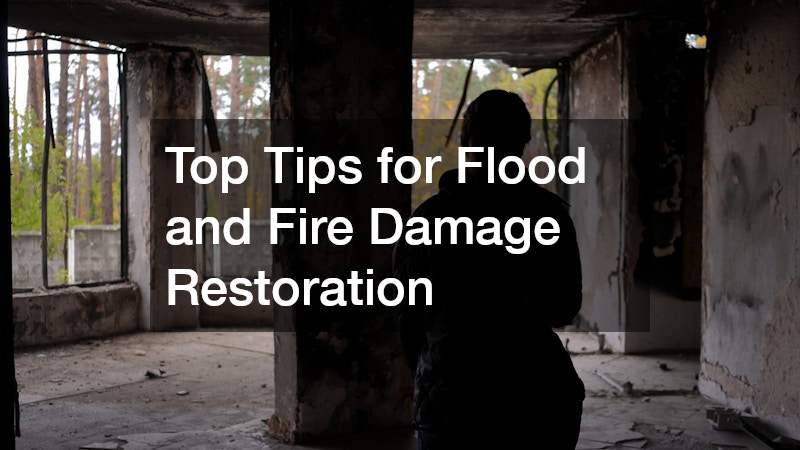
In this article, we delve into crucial strategies for restoring flood and fire damage to your property. Delve deep into understanding the best practices to effectively manage aftermath property damage, ensuring safety and efficiency. By adhering to these guidelines, property owners can restore their properties to their former glory, minimizing stress and potential financial loss. Whether dealing with a minor leak or a devastating blaze, having a restoration plan in place can dramatically reduce your recovery time and costs.
1. How do I assess the extent of property damage?
Assessing the extent of flood and fire damage is the first critical step in the restoration process. Aftermath property damage can vary greatly, ranging from superficial to structural, necessitating a comprehensive evaluation. It is advisable to work with professionals who specialize in flood and fire damage restoration, as they can provide expert insight into hidden damages. These professionals often follow a standardized protocol to ensure nothing is overlooked—from roofline to subfloor.
Inspection should start with visible signs such as smoke stains, water marks, or damaged flooring and ceilings. Following the initial inspection, structural elements like walls, foundation, and support beams should be checked for integrity. Professional tools such as hygrometers and infrared cameras can detect moisture and heat patterns that might indicate underlying issues. These tools are crucial in identifying damp pockets within walls or ceilings that can later develop into mold colonies or cause material deterioration.
Aftermath property damage extends beyond the physical state; considering emotional and financial impacts is also crucial. Documenting all damage with photos and detailed notes will aid in insurance claims and subsequent restoration efforts. Open communication with insurance representatives will ensure comprehensive coverage acknowledgment for flood and fire damage restoration expenses. Maintaining a digital backup of all records in cloud storage can further streamline claim processing and record-keeping.
2. What are the first steps in flood damage restoration?

The initial step after any flooding event is to ensure the area is safe and to stop further water ingress. Engaging the services of basement waterproofers can prevent future damage by reinforcing vulnerable areas against water penetration. Removing standing water is crucial to prevent further structural weakening and mold growth. Failure to address standing water within 24–48 hours can result in irreversible damage to flooring and drywall.
Professional flood and fire damage restoration experts recommend using specialized equipment such as pumps and dehumidifiers to address large pools of water. Immediate action helps mitigate the severity of the damage, thereby reducing aftermath property damage. Proper ventilation of affected areas is essential for drying out walls and floors quickly. Industrial fans and negative air pressure systems are often used to accelerate drying time and reduce microbial growth.
After ensuring water removal, it’s important to sanitize and dry the affected areas thoroughly. This not only halts the propagation of mold and bacteria but ensures the living environment is safe. Employing cleaning services that specialize in flood restoration can be extremely effective in this regard. They are trained in the safe use of biocides, which can prevent harmful pathogens from spreading throughout the property.
3. How can I restore my home after fire damage?
Restoring a home after fire damage involves several meticulous steps, starting with assessing structural integrity and fire residue. Utilizing a professional cleaning service is recommended for removing soot and smoke stains from walls and fabrics. Aftermath property damage from fires often includes compromised roofing and windows, which need prompt attention. Temporary boarding of broken windows or roofing is often necessary to protect the interior from weather exposure and vandalism.
The process of fire restoration involves cleaning, deodorizing, and repairing the property. Professional teams can use specialty equipment to remove residual odors and ensure water used to extinguish the fire does not contribute to further damage. It is critical to check the integrity of electrical systems and installations to prevent future hazards. Inspections should be done by licensed electricians, as fire can weaken wire insulation and cause short circuits.
Attention to detail during restoration, such as ensuring proper insulation and carpet installation, can facilitate a quicker return to normalcy. Replacing or cleaning carpets and other soft furnishings, often done by carpet cleaning companies, ensures that lingering smoke odors do not re-penetrate newly restored spaces. This process is a crucial component of flood and fire damage restoration. High-efficiency particulate air (HEPA) vacuums and ozone treatments can be used to cleanse the air of fine soot particles and odors.
4. What safety considerations should be taken after a fire or flood?

Safety is paramount following a fire or flood, making the evaluation of structural safety issues a priority. Whether it’s checking for electrical dangers, gas leaks, or compromised buildings, each aspect requires scrupulous attention. Engaging professionals such as electricians and structural engineers early can mitigate risks associated with aftermath property damage. Their assessments often include load-bearing capacity, moisture levels in framing, and HVAC system integrity.
When it comes to flooring, ensuring that carpets are properly sanitized or replaced is essential to avoid health hazards. Carpet installation should only proceed once underfloor conditions are verified as dry and sound to prevent mold growth. Working with experts from carpet cleaning companies guarantees adherence to safety standards during this process. Mold can grow undetected beneath improperly dried carpets, leading to respiratory issues and costly remediation.
Personal protective equipment such as masks and gloves should be worn whenever inspecting damaged areas. This protective gear not only shields against hazardous materials but prevents respiratory complications from lingering smoke or toxic substances. Safety protocols must be strictly followed to safeguard occupants during flood and fire damage restoration. Additionally, securing the site with caution tape or signage helps prevent unauthorized access during restoration.
5. How can I prevent future flood and fire damage?
Prevention is key in mitigating the risks of recurring flood and fire damage. Implementing basement waterproofers is a proactive step towards safeguarding properties against future water infiltration. Regular maintenance and checks should ensure that roofing systems and drainage solutions are equipped to manage heavy rainfall or snow melts.
Downspouts should direct water at least five feet away from the home’s foundation to prevent seepage.
Fire prevention strategies should include installing and maintaining smoke detectors throughout the home. Additionally, ensuring that quartzite countertops and other fire-resistant materials are used in areas prone to high heat can significantly reduce fire spread. Engaging in regular fire drills equips occupants with the knowledge required to act swiftly in an emergency. Proper storage of flammable materials and routine checks of heating appliances can further reduce fire risks.
Building strong relationships with service providers, such as cleaning services and carpet cleaning companies, can ensure rapid response times. Regular evaluations of these preventive measures can dramatically reduce the potential impact of aftermath property damage. By anticipating risks and preparing accordingly, property owners can safeguard their homes more effectively. Establishing a disaster readiness plan can provide clear next steps and reduce panic during an actual emergency.
6. What types of insurance should cover flood and fire damage?

Property insurance covering flood and fire damage is essential in protecting against the financial burdens of aftermath property damage. Most standard homeowner’s insurance policies offer coverage for fire-related damages but may exclude floods. To comprehensively protect against water-related damages, it’s advisable to invest in separate flood insurance policies. Flood policies are often issued through the National Flood Insurance Program (NFIP), especially in high-risk zones.
Reviewing existing insurance coverage with a professional can help clarify the nuances and gaps of each policy. Engaging the services of a qualified brava installer for roofing assessments and upgrades can be beneficial when working with insurance companies, as it shows proactive risk management. After a disaster, an accurate claim ensures appropriate coverage for all restoration costs. It’s helpful to keep all receipts and contractor invoices as supporting documentation for your claim.
Understanding insurance policy stipulations and reading the fine print is critical in preemptively managing aftermath property damage. Discussing options with insurance advisors can facilitate the choice of adequate policies tailored to personal risks and property specifics. Regular updates and reviews of policies can avert denial of claims during critical times. Policyholders should also document all valuables and consider a rider for high-value items like jewelry or electronics.
7. How can I handle belongings after flood or fire damage?
Post-disaster strategies for handling personal belongings greatly affect the restoration timeline and long-term satisfaction. After a flood or fire event, assessing which items are salvageable and which must be discarded is paramount. Salvage efforts should involve swift actions to prevent mold, odors, and additional aftermath property damage. Using sealable plastic tubs for temporarily storing affected items can reduce further contamination.
Employing professional restoration services can adeptly handle the cleaning and restoration of delicate items. Items such as quartzite countertops and other valuable surfaces may require specialized materials and skills to restore their original condition. By using qualified cleaning services, valued possessions have the best chance of being restored. For electronics, specialized drying and diagnostic services may salvage equipment that initially appears ruined.
Transportation of affected items to off-site locations allows for efficient sorting and restoration. Companies experienced in handling belongings post-disaster offer climate-controlled storage to prevent additional damage. This diligence in managing personal effects after flood and fire damage restoration can preserve cherished items long into the future. Inventorying belongings by category and photographing them aids in both tracking and insurance reimbursement.
8. When should I consider hiring restoration professionals?

Knowing when to call on the expertise of restoration professionals can greatly impact the restoration process’s success. Complex and large-scale aftermath property damage often involves situations beyond DIY repair capabilities, such as structural or hazardous challenges. For extensive tasks like dock leveler replacements or electrical system diagnostics, professional guidance is indispensable. Signs that professionals are needed include deep water saturation, visible mold, sagging ceilings, or foul odors that persist.
Professionals bring precision, technical know-how, and specialized equipment necessary for successful restoration. They are also skilled at navigating insurance claim processes, acting as an intermediary between homeowners and insurance companies. This expertise can speed up the reconstruction process and help overcome logistical challenges efficiently. Their presence can also provide emotional reassurance during what is often a chaotic and distressing time.
Ultimately, the decision to hire restoration professionals should be informed by the scale of damage, safety considerations, and personal comfort level with handling repairs. Soliciting quotes and project plans from multiple service providers fosters informed decision-making. Acting promptly as needed guarantees that flood and fire damage restoration is comprehensive and effective. Choosing certified restoration specialists can also ensure that repairs meet code and inspection requirements.
9. What is the role of technology in damage restoration?
Technology plays an increasingly critical role in modern flood and fire damage restoration. Advanced tools like thermal imaging cameras and moisture meters enable precise assessments of hidden aftermath property damage. Equipment such as ridgid pipe threaders for plumbing repairs ensures comprehensive and robust solutions to complex challenges. These tools enhance both accuracy and efficiency, minimizing guesswork and unnecessary demolition.
Incorporating state-of-the-art technology facilitates more efficient debilitating issue resolutions, from structural drying technologies to ozone generators for odor removal. New developments in tech-based restoration enhance accuracy and speed, driving improved outcomes. Documentation processes have likewise evolved, with apps and software enabling real-time tracking and communication. This transparency also improves homeowner trust and contractor accountability.
Employing technologies in restoration efforts also yields cost efficiencies by reducing labor-intensive tasks. Automation and predictive analytics assist professionals in planning and executing precise recovery strategies. Overall, the smart application of technology secures faster recovery times and improved quality of workmanship. Future-forward companies also leverage drones for roof inspections and damage assessments.
10. How do environmental factors influence damage restoration?
Environmental factors significantly influence the success of flood and fire damage restoration efforts. Variances in climate, soil type, and local infrastructure can determine the degree of aftermath property damage and the strategies employed in recovery. Excess rainfall may affect groundwater levels, requiring robust drainage systems such as asphalt curbs to control flow and prevent water ingress.
Homes built on clay-heavy soil may be more prone to foundation shifts during flood conditions.
Regional climatic trends and forecasts can guide long-term preventive actions, ensuring properties are future-proof against local weather patterns. Adjustments in restoration plans accommodate elements such as humidity, ambient temperature, and environmental contaminants, which may affect building materials. This tailored approach ensures applicable methods that respect and complement nature. In wildfire-prone areas, using fire-retardant construction materials can improve future outcomes.
Environmental awareness is crucial in promoting sustainable restoration practices that reduce energy consumption and support local flora and fauna. The integration of eco-friendly materials and processes contributes to the minimization of ecological footprints. Recognition and accommodation of environmental factors ultimately support more resilient and sustainable restoration outcomes. Working with green-certified contractors can also help meet sustainability goals and local building codes.
Effective flood and fire damage restoration is crucial in maintaining the structural and financial integrity of a property. By understanding and implementing the outlined tips and strategies, individuals can handle the aftermath property damage with confidence and foresight. Collectively, these strategies empower homeowners to navigate the complex landscape of restoration, ensuring that health, safety, and economic wellbeing remain uncompromised. With preparation, professional help, and the right tools, recovery doesn’t just become possible—it becomes sustainable and smarter.



